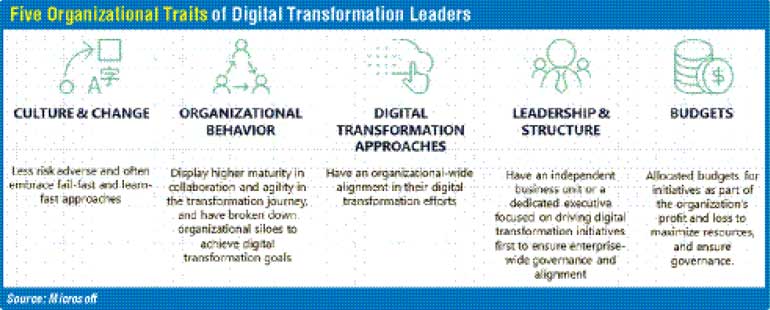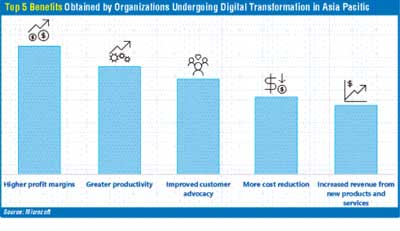Thursday Jan 08, 2026
Thursday Jan 08, 2026
Monday, 26 February 2018 00:00 - - {{hitsCtrl.values.hits}}

By 2021, digital transformation will add an estimated USD1.16 trillion to Asia Pacific’s GDP, and increase the growth rate by 0.8% annually, according to a new business study released recently.
The research, entitled “Unlocking the Economic Impact of Digital Transformation in Asia Pacific ”, was produced by Microsoft in partnership with IDC Asia/Pacific.
The study predicts a dramatic acceleration in the pace of digital transformation across Asia’s economies. In 2017, about 6% of the region’s GDP was derived from digital products and services created directly through the use of digital technologies, such as mobility, cloud, Internet of Things (IoT), and Artificial Intelligence (AI). This is expected to surge to around 60% of Asia GDP by 2021.
The survey conducted with 1,560 business decision makers in mid and large-sized organizations across 15 economies in the region highlights the rapid impact and widespread disruption that digital transformation is having on traditional business models.
Respondents to the study identified five key benefits to their bottom line from digital transformation:
According to the research findings, business leaders are already seeing 15% to 17% improvements across these benefits from their efforts today, and they expect to see more than 50% improvements in those key areas by 2020, with the biggest jump expected in customer advocacy.
“Digital transformation has a positive and measurable impact on Asia Pacific’s economy, and it is widely regarded that every organization needs to be a digital one,” said Ralph Haupter, President, Microsoft Asia. “In fact, customers that we are speaking to are increasingly deploying emerging technologies such as artificial intelligence as part of their digital transformation initiatives, and that will accelerate growth even further.”
Digital Leaders in Asia Pacific to Gain Lion’s Share of Economic Opportunities
While 84% of organizations in the region are in the midst of their digital transformation journey, only 7% can be classified as Leaders. These are organizations that have full or progressing digital transformation strategies, with at least a third of their revenue from digital products and services. In addition, these companies are seeing between 20 - 30% improvements in benefits across various business areas from their initiatives.
The Study indicates that Leaders experience double the benefits of followers, and these improvements will be more pronounced by 2020. Almost half of Leaders (48%) have a full digital transformation strategy in place.
“The pace of DX is accelerating, and IDC expect that by 2021, at least 60% of Asia/Pacific GDP will be digitalized, with growth in every industry driven by digitally-enhanced offerings, operations and relationships. The study shows leaders seeing double the benefits of followers, with improvements in productivity, cost reductions, and customer advocacy. To remain competitive, organizations must establish new metrics, realign organization structures, and rearchitect their technology platform,” said Daniel-Zoe Jimenez, Research Director Digital Transformation Practice Lead, IDC Asia/Pacific.
The Study identified key differences between leaders and others in Asia Pacific, which contribute to the improvements tracked:
The digital economy has also given rise to new types of competitors, as well as emerging technologies such as Artificial Intelligence that have contributed to the disruption of business models.
nMeasuring digital transformation successes: Organizations across Asia Pacific are starting to adopt new key performance indicators (KPI) to better measure their digital transformation initiatives, such as effectiveness of processes, data as a capital, and customer advocacy in the form of Net Promoter Score (NPS). As organizations realize the potential of data as the new oil for the digital economy, leaders are much more focused on leveraging data to grow revenue and productivity, and to transform business models.
What sets leaders apart from others are their abilities to ride on the digital transformation wave from an organizational culture perspective. The Study found that leaders have these traits:

“Winners will take all in the digital transformation race, and thus it is crucial for organizations to adopt a Leaders’ mindset when approaching digital transformation initiatives. To do so, organizations need to build up their ecosystem – from employees, to customers, to partners – in order to grow their value chain by gaining new insights through new data sources, expanding their digital products and services, and ultimately growing their data as a capital asset,” said Haupter.
“Microsoft is uniquely positioned to help organizations in Asia to succeed in their digital transformation journeys today through our agile platforms and solutions that prioritize flexibility, integration and trust. As an organization that has also undergone digital transformation, we understand what organizations will need to make their journeys a successful one.”
Digital Transformation in Asia will Ultimately Benefit Citizens
According to the business leaders surveyed, digital transformation will bring about these top three benefits to society:
1. Smarter, safer and more efficient cities
2. Creation of more higher value jobs
3. Potential increment to personal income through freelance and digital work
In addition, 85% of respondents felt that jobs will be transformed in the next three years due to digital transformation, and half of the jobs in market today will redeployed to higher value roles, or reskilled to meet the need of the digital age.
“The rise of digital transformation in Asia Pacific economies will affect the labour market where many types of jobs will evolve and change. In past industrial revolutions, workers were reskilled to deliver higher value output to meet increased market demands, resulting in jobs transformation. What is encouraging is that two thirds of respondents are confident that their young employees already have future ready skills that will help them to transition to new roles,” said Haupter.
“There is also concern about displacement of jobs due to digital transformation. The Study, however, found that digital transformation will not reduce the number of jobs. According to business leaders, 26% of new jobs will be created from digital transformation, which is about the same number of jobs that will be automated, or about 27%; in other words, the effect will be neutral. Despite the impact being mitigated, governments and organizations should still focus on reskilling, upskilling and continuous learning will be important in ensure successful workforce transformation for the digital age.”
Riding the Wave of Digital Transformation
Organizations in Asia Pacific need to accelerate their digital transformation journey to reap full benefits of their initiatives, and to address the invisible revolution brought about the mass adoption of AI. More importantly, companies need to focus on capitalizing their own data in order to gain new market insights, create new digital products and services, and monetize data through data sharing securely, and in collaboration with its ecosystem.
Microsoft recommends organizations adopt the following strategies to become a digital transformation leader:
1. Create a digital culture: An organization needs to build a culture of collaboration where it is connected across business functions, and has a vibrant and mature ecosystem of customers and partners. Data can then be embraced across organization and functions, where better decisions can be made and ultimately serve the needs of customers and partners better.
2. Build an information ecosystem: In a digital world, organizations are capturing more volumes of data internally and externally. The key to becoming a leader is for organizations to be able to convert data into capital assets, and enable data sharing and collaboration internally and externally in an open yet trusted manner. In addition, a proper data strategy will allow businesses to start their AI initiatives to identify connections, insights and trends.
3. Embrace micro-revolutions: In most cases, digital transformation efforts do not start with widespread change, but a series of micro-revolutions. These are small, quick projects that deliver positive business outcomes and accrue to bigger and bolder digital transformation initiatives.
4. Develop Future Ready Skills for Individuals and Organizations: Organizations today must relook at training and reskilling its workforce so that workers are equipped with future ready skill sets such as complex problem solving, critical thinking and creativity for the digital economy. More importantly, they need to rebalance the workforce to attain and attract key digital talents, as well as be open in creating a flexible work source model where they tap into skills-based marketplace. From a digital skills perspective, LinkedIn’s latest study outlines the ABCs of digital talents required for future economies in the region – artificial intelligence, big data and cloud computing.
Footnotes
Unlocking the Economic Impact of Digital Transformation in Asia Pacificconducted with 1,560 respondents in 15 markets:
15 Asia Pacific markets were involved: Australia, China, Hong Kong, Indonesia, India, Japan, Korea, Malaysia, New Zealand, Philippines, Singapore, Sri Lanka, Taiwan, Thailand and Vietnam.
Business and IT leaders from organizations with more than 250 staff were polled.
Industries polled included education, financial services, government, healthcare, manufacturing and retail.
Respondents are decision makers involved in shaping their organizations’ digital strategy.